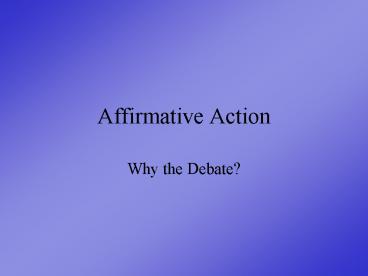Affirmative Action PowerPoint PPT Presentation
1 / 11
Title: Affirmative Action
1
Affirmative Action
- Why the Debate?
2
What is Affirmative Action?
- Affirmative action is a government policy/program
that seeks to redress past injustices against
specified groups by making special efforts to
provide members of these groups with the access
to educational and employment opportunities - Introduced as a means of integration
- Affirmative Action also dealt with issues
revolving around equal opportunity employment and
federal contract compliance -
3
The Key Issue
- On whom should the burden of proof in Affirmative
Action cases be directed, on the plaintiff (i.e.
the employee) or the defendant (i.e. the
employer)? - A series of court cases would address this
question as well as the constitutionality of the
Affirmative Action initiative
4
Regents of the University of California v. Bakke
(1978)
- A white male named Allan Bakke sues the U of
California at Davis Medical School on the basis
that he had been denied admission because of his
race - The school had reserved 16 percent of the
admission slots for minorities - Bakke won his case and was admitted
- However, Affirmative Action not ruled
unconstitutional - Quota system rejected but being a minority could
be used for consideration in these decisions
Courtesy www.maxwell.syr.edu/plegal/scales/bakke
vis.html
5
Wards Cove v. Atonio (1989)
- Further supports Bakke case
- Burden of proof shifted from the defendant (the
employer) to the plaintiff (the employee claiming
discrimination) - Also, A. Action policies already approved by fed.
courts could be challenged by non- minorities
claiming discrimination
6
Adarand Constructors v. Pena (1995)
- Further weakened A. Action
- all A. Action policies put under strict scrutiny
by govt - Clintons idea to mend, not end A. Action
7
Hopwood v. State of Texas (1996)
- White students said that the admission practices
discriminated against them - The US Court of Appeals for the Fifth Circuit
(applies to some states, not all) supported their
case, outlawing race considerations for
scholarships and admission in state schools - A lot of back and forth cases followed
Courtesy LA Times. http//www.latimes.com/include
s/ramirez/ramirez_20030624.gif
8
Gratz v. Bollinger (2003)
- Bollinger, the president of the U of Michigan,
accused that the admissions point system (giving
minorities 20 out of 150 points) promoted
discrimination - Received a lot of news attn.
- Court decided that this point system was as bad
as quota system rejected in Bakke
9
Grutter v. Bollinger (2003)
- Challenged U of Ms Law School admissions
practices - Court allowed race to be considered (not used in
a mechanical way) in admissions but the policy
was to be still under strict scrutiny - strengthened A. Action
10
Is Affirmative Action Helpful?
- YES
- compensates for past injustices
- levels the playing field
- is not a big issue when there is equal
credibility among candidates - even with A.Action, white males hold around 95
percent of high level corporate jobs - discrimination still a serious problem
- veterans get benefits and preference as well as
their descendents - racism prevents talented minority candidates
from landing the job they want (Shouger
Merchant) - Is not perfect, but is a step towards equality
- Mend it, dont end it (President Clinton)
- NO
- minorities statistically have higher failure
rates - promotes discrimination to non-minorities
- hinders minorities credibility and respect
- not responsible for ancestors indiscretions
- promote inequality
- minority students should not have to defend
themselves and their accomplishments (Nicole
Marklein) - classification of race is becoming increasingly
difficult - If they dont want me because Im black, I dont
want to work with that company anyway. Who wants
to be in a racially discriminatory workplace?
(Anonymous)
11
- This debate is far from over. Court cases and
rulings will continue in the future and may
reshaped the use of Affirmative Action procedures.
Sources Ginsberg, B., Lowi, T., Weir, M.
(2005). We the People (5th ed.). New York W.W.
Norton and Company Inc. Marklein, Nicole. (2003,
October 1). Affirmative Action Decision a Missed
Opportunity. Badger Herald. (University of
Wisconsin - Madison). Merchant, Shouger. (2004,
April 26). Affirmative and Negative Action.
Daily Illini. (University of Illinois).

